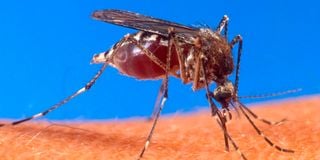Deadlier mosquito from Asia linked to new malaria outbreaks in Africa

The World Health Organization (WHO) has announced a new initiative to stop the spread in Africa of a malaria-causing mosquito species originally from Asia.
What you need to know:
- A new study has linked the invasive insecticide-resistant mosquito native to South Asia to an unprecedented urban outbreak of malaria in Ethiopia.
- The mosquito is a significant threat to the goal of eliminating malaria on the continent.
As Africa grapples with eliminating malaria, a new deadlier mosquito species that arrived inside shipping containers from Asia has been spotted in Ethiopia.
Now a new study has linked the invasive insecticide-resistant mosquito native to South Asia to an unprecedented urban outbreak of malaria in Ethiopia.
The species thrives in urban environments.
The findings follow reports of a suspicious 40-fold rise in malaria cases in neighbouring Djibouti since 2013, with novel evidence that this mosquito, which was not confirmed in the region until 2012, is a significant threat to the goal of eliminating malaria on the continent.
According to Dr Fitsum Tadesse, a molecular biologist with the Armauer Hansen Research Institute in Addis Ababa, an outbreak in Dire Dawa, a city of about 500,000 people in eastern Ethiopia that typically records only about 200 cases a year, reported about 2,400 cases between January and May this year.
While making a presentation on their findings during the Annual Meeting of the American Society of Tropical Medicine and Hygiene, Dr Tadesse and his colleagues explained that their investigations found the surge was caused by a mosquito known as Anopheles stephensi.
They also found that the mosquito was resistant to the insecticides most commonly used to control malaria via treated bednets and indoor insecticide spraying.
This is the most compelling evidence to date that the mosquito is fast expanding its range.
“Malaria in Africa is typically associated with rainy seasons in rural areas, but this mosquito produced a ten-fold spike in malaria infections in just three weeks in an urban area during a dry season. Unlike the mosquitoes that typically transmit malaria parasites in Africa, this one is best known for its ability to thrive in man-made water storage containers like what you see in rapidly expanding urban neighbourhoods,” the expert said.
Rainy seasons
Most malaria in Africa is caused by a mosquito species known as Anopheles gambiae, with populations rising and falling with the rainy seasons that swell rural waterways while the Anopheles stephensi mosquitoes have long been the primary transmitter (vector) of malaria in urban areas of India and Iran.
“But they were never seen in Africa until 2012, when they were reported from Djibouti, a tiny East African country of about one million people that, at the time, had been close to eliminating the disease. An. stephensi mosquitoes likely arrived in shipping containers, “Tadesse said.
“They did not appear to be a significant threat until 2020, when they were suspected as the cause of the steadily rising number of malaria infections in Djibouti since 2013.”
According to the researchers, in recent years, progress against the disease has stalled.
“This is not like any other malaria-carrying mosquito we have seen in Africa before,” said Dr Sarah Zohdy, a disease ecologist and An. stephensi expert with the US Centers for Disease Control and Prevention.
“This mosquito’s ability to persist in the dry season and in urban environments has the potential to alter the landscape of malaria in Africa,” she said while adding that it could cause malaria to expand from a predominantly rural disease to both a rural and urban challenge that also impacts Africa’s rapidly growing and densely populated cities, where infection rates have been comparatively low.
Meanwhile, a separate study presented at the ASTMH Annual Meeting reported new evidence that An. stephensi mosquitoes are ubiquitous in and around households across nine states in Sudan.





